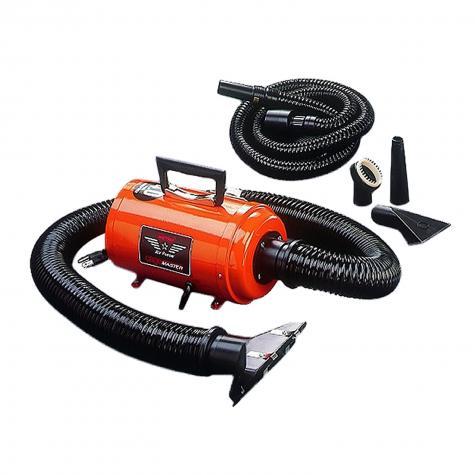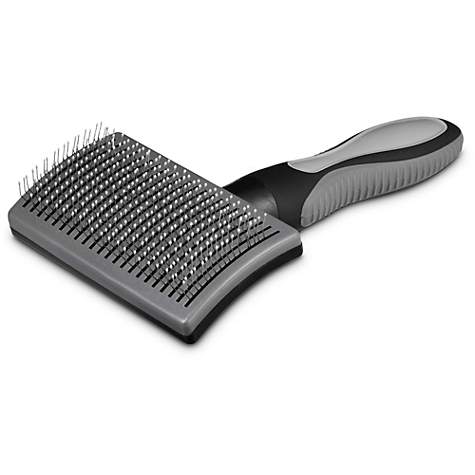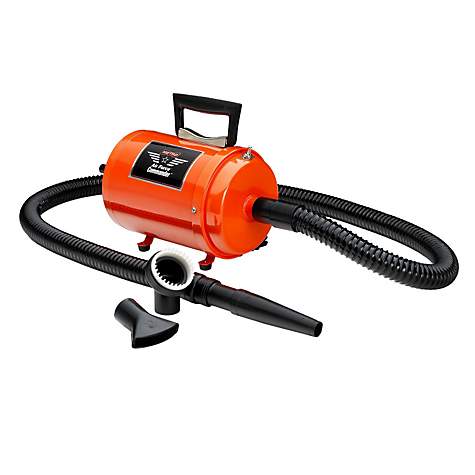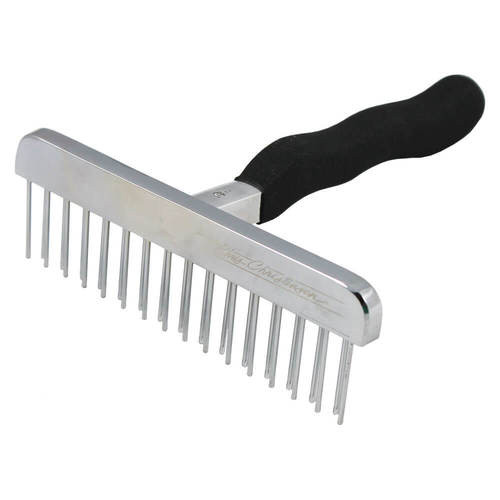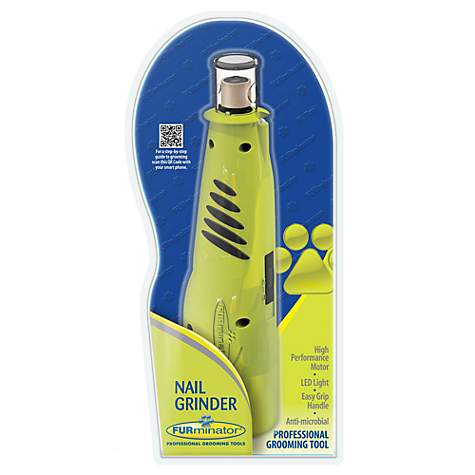Dog Showing for Beginners

There are many kinds of competitions for dogs - obedience, agility, tracking and others. However, one of the most confusing is "conformation" - or the beauty contest-type competition as most people think of them. In obedience the dog is judged on how he performs commands, in agility it's how fast and effectively he goes over the jumps and through the tunnels - but what are they looking for at a conformation "Dog Show"? Actually, it's much more than beauty - it's structure, temperament, coat, and other qualities that collectively make that animal one that is a good representative of it's breed. It must have "type" or LOOK like a Malamute. It must conform to the AKC standard written to describe the perfect specimen (which no dog can ever attain, but we try). Those are the things a judge is supposed to be looking for.
Conformation Dog shows can be pretty confusing. You arrive to find the dogs you wanted to see have already left, so you decide to watch another breed. Breeders seem preoccupied and busy grooming. You hate to bother them so go watch the action. But that's just as confusing - people with dogs run in, run around, run out. What happened????? Who won???? What is going on! Hopefully this will help. Dog shows can best be described to the uninitiated as a "beauty contest" for dogs - but there is more to it than beauty. Just as Miss World has to show talent and poise, so do show dogs. Not exactly talent, though Malamutes should demonstrate potential working ability by having correct structure, muscle, feet , coat, temperament, and a mysterious thing called "type" (will explain later). The handler (person showing the dog) has the job of presenting the dog to the judge. Though it LOOKS easy, it's not. This person must know how to get every ounce of personality and pizzazz out of the dog, all the while showing off the dog's good points and minimizing the bad. Also, some owners will hire "professional" handlers - people who are experts at handling - to make their dogs look good (it's also politically helpful).
First, lets take a look at how the judge narrows down his choices. This information pertains to all-breed American Kennel Club shows. UKC (United Kennel Club), CKC (Canadian), European, and other groups use different systems to narrow down the competition to the "Best dog in the Show". At non-AKC shows for example, there may be a Best Puppy in Show competition or titles such as "Grand Champion" but these are not used in AKC competition. At Specialties (only one breed of dog is entered) the highest honor is Best of Breed (since there are no other breeds to comMalamutee with). There will not necessarily be a dog entered in EVERY category. (That's why it's sometimes confusing). If no 6-9 month puppies entered, there won't be a category for them. So every show is slightly different.

Often you won't know what's happening next because it's so subtle. A nod from the judge, the handlers line up their dogs, someone hands out ribbons and they leave the ring. The only way for a newbie to dog shows to know what's going on is to buy a catalog and watch closely. The catalog is available for about $5-10 at the Superintendent's table. (The Superintendent is the company that helps put on shows for the show-giving club). This is usually a nicely skirted table, piled with either information, gifts, or prizes - usually near an entrance. The catalog tells you the time, ring, judge and who is showing. In the back are the exhibitors addresses. It tells you the armband number of the exhibitors so you can identify which dog is which and tells you the order they will be shown in and what class.
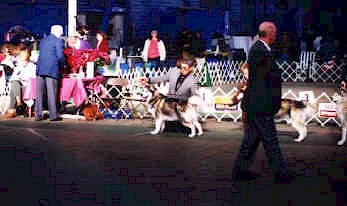 Photo by Glen Schroeder
Photo by Glen Schroeder
These dogs are "stacking" so the
judge can look at them and compare their structure standing. The man at
the left is the ring steward. He calls exhibitors into the ring, takes
care of the ribbons, and assists the judge. The man on the right evaluating
the dogs is the judge.
Now find yourself a place ringside. You may want to bring your own chair as there are never enough. If you watch closely, you will see dogs with the numbers in your book file into the ring. If the ring steward says "catalog order" the participants must position themselves in the order they are listed in the catalog. If he doesn't, they may place themselves in any order. The judge usually has the handlers "stack" (or stand) the dog and then has them move around the ring together once or twice. They return, stack the dog again and the judge then individually goes over and moves each dog.
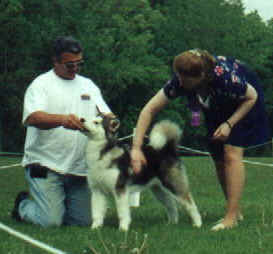
Holly is "gone over" at a Match show
The judge will feel the dog's muscle and bone, check teeth, coat, sometimes even bait the dog with a treat to see the expression on his face. Then the judge will ask the handler to individually move the dog, usually in a diagonal down and back in the ring. This is to see forward and rear movement. Then the dog will do another circle around the ring (so the judge can view side movement) and go to the end of the line so the next dog can be judged. A good handler presents his dog well and the dog will be well-trained to stand still for the judge and move at the proper gait (speed). A good handler makes showing a dog look effortless. Very subtle gestures or control on the part of the handler can make a dog look good or awful. Therefore, if you plan to show your dog, it is a good idea to take classes in "handling" so that you can present your dog well. It's not nearly as easy as it looks!
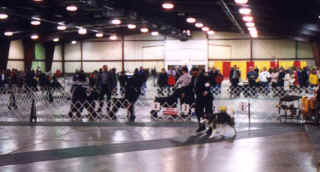 Photo by Glen Schroeder
Photo by Glen Schroeder
Moving individually, down and back.
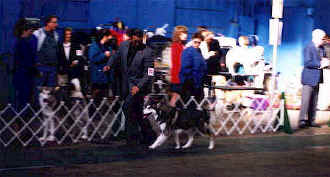 Photo by Glen Schroeder
Photo by Glen Schroeder
Then each dog goes around the ring
to the end of the line.
The judge moves each dog at a trot so that he can see it's movement. A good-moving dog is a soundly put together dog. The dogs are not allowed to pace or run, and if they do the handler may start over. After each dog is judged individually, the judge will ask them to move around the ring together. Then he will make his decision. If you aren't looking you'll miss it. Usually the judge will just point and the exhibitors will go stand by the table. There are signs on the fencing indicating the placings. They will position themselves in the order they were chosen - closest to the table is 1st through 4th place. Mark your catalog with the armband numbers of the handlers standing by those signs so you will have a record of the winners for the next level of competition (Winners or Breed competition).
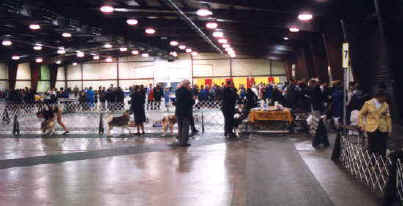 Photo
by Glen Schroeder
Photo
by Glen Schroeder
Nova has just received "1st" in
her "class"-
she is 1 of 4 standing closest to the table after the judge makes his decision.
After the last "class" group is judged, the winners of each class will return so the Winner's Dog (or Bitch) can be chosen. The ring procedure is repeated (each judge determines his own ring procedure so it may vary slightly). The winning dog and winning bitch will get a solid purple ribbon. The "runner up" or Reserve dog will get a purple and white ribbon. These winners - dog and bitch - will return to the ring later with dogs that are finished Champions to comMalamutee for Best of Breed, Best of Opposite and also between just the two of them - Best of Winners. If you become lost, the catalog is important to help you find out what is being judged. Check the armbands of the handlers in the ring and look to see what class they are in. This will tell you what is being judged. Again, when the winners are chosen, there are small signs on the fencing they will stand by so that observers can tell who won what. When the Best of Breed, Best of Opposite (which is the best dog of the opposite sex to the Best of Breed), and Best of Winners is chosen, the Breed judging is over.
Ordinarily most exhibitors will leave for home after being judged, except the dog that won Best of Breed, because many have come long distances to participate and have a long drive home. This is why you'll go to a show and will only see 1 dog of the breed you intended to research. They had already been judged and left, since only the Best of Breed dog will stay for the next level of judging. The "Best of Breed Winner" will go back in another ring later in the day with all of the other dogs in their "Group" (Malamutes are in the Working Group) that won their respective Best of Breeds. The best Alaskan Malamute will comMalamutee against the best Doberman, Newfoundland, Rottweiler, etc. for Best in Group. In the Group, the judge will choose 4 winners - Group 1, Group 2, Group 3, Group 4. Only the "Group 1" winner goes on to comMalamutee against every other Group 1 winner for Best in Show. At this level you will notice the handlers seem very different. Group wins are a big deal, competition is fierce, and often dogs are shown by professional handlers who are paid to walk in the ring and show the dog. After the winner is chosen from each group, the 7 Group Winners comMalamutee for the coveted title of Best in Show. All this takes several hours. Most shows begin about 8:00-9:00 a.m. and end roughly about 4:00-5:00 p.m. If you are looking for a specific breed, it's wise to contact the club or superintendent to find out when your breed will show or you may miss them.
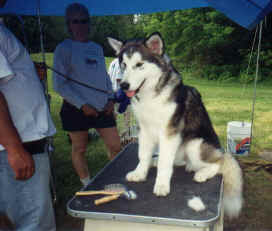
A very simplified chart of each level of an AKC dog show.
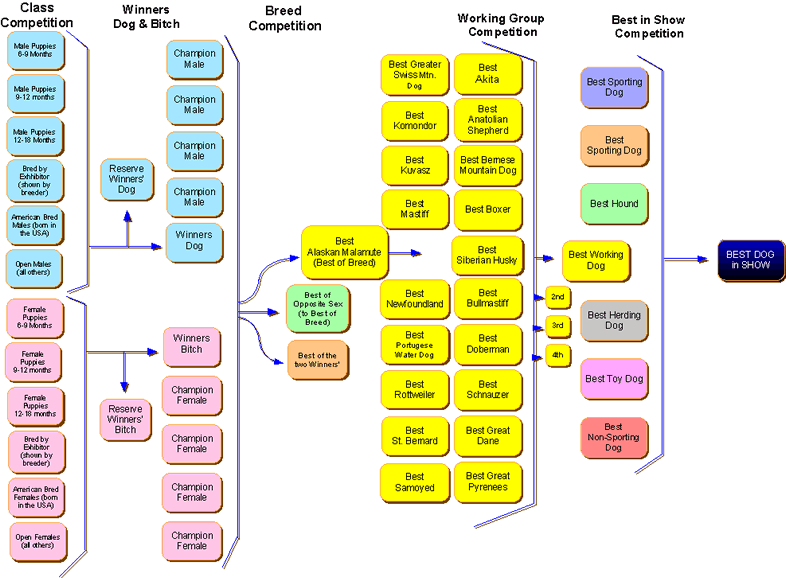
Talking to Breeders
Most breeders love to talk about their dogs! However, choose your time carefully. Showing can be very intense and often a handler is not willing to chat just before going into the ring, instead wishing to concentrate on his dog and the competition. The best time to talk is after competition, or sometimes if you see them leisurely grooming ahead of time. (If they seem rushed, they probably are). It is always polite to ask if this is a good or bad time to ask questions. And it's always polite to congratulate someone on a win!
What is a Champion?
Dogs comMalamuteing in dog shows are comMalamuteing for points toward a championship title. They rarely win any money (a common misconception) or prizes. Occasionally a particular show will offer small prizes such as dog dishes, treats, or fancier ribbons to entice exhibitors to enter, but this is not usually the case and is more common for larger shows or "specialities" where there is a large number of a specific breed entered. It takes fifteen points, including two "majors" (wins of 3, 4 or 5 points) under 3 different judges to be an AKC Champion. At any one show a dog can earn from 1 to 5 points toward a Championship title depending on the number of males or females in competition for the breed. The dog receives the points for defeating "class" dogs, and winning "Winners Dog" or "Winners Bitch". If a dog (or bitch) wins "Best of Winners" they can get the points of the points of the dog defeated if it is more than their own win would have been. For example, if the Winners Bitch defeats the Winners Dog and gets "Best of Winners" and the dog classes were worth 3 points, but the bitch classes were only worth 1 point, she would receive the points for the dog class instead (3 pts.) Once a dog is a Champion (15 pts.), it can comMalamutee for Best of Breed without having to comMalamutee first in the other "classes". Only the Winner's Dog and Winner's Bitch receive points at a show. In Canada the point schedule and judging will be similar but slightly different. In Canada 10 points are required for a Championship, no major points are needed. Also, often there will be judging for "Best Puppy in Show" and also neutered classes for spayed and neutered dogs so a dog does not have to be intact to comMalamutee.
Miscellaneous Tips and Tidbits (Dog Show Ediquette)
- Don't bring your Malamute to watch. Unless your dog was obtained from an exhibiting breeder and he wants to evaluate it, unentered dogs are not allowed. This is especially so for indoor shows.
- In the summer expect to be sitting in the hot sun or rain and dress accordingly. In the winter, most shows are indoors and often very hairy. Dress accordingly even though exhibitors in the ring are expected to "dress-up" in dresses and suits when exhibiting their dogs.
- Be considerate - don't make rude or overly critical comments about dogs in the ring. It's ok to discuss what you see, but note the good as well as the bad. There is no perfect dog!
- Keep children under control, and don't allow them to Malamute dogs they don't know without permission. Dogs are dogs and many show dogs are not used to small children. Watch that strollers don't run over a dog's tail. Always ask before touching as some dogs are painstakingly groomed before showing.
- If you plan to meet someone (such as your dog's breeder), find out where they plan to set up their grooming equipment. As a backup, know what time they show and in which ring. It can be difficult to find someone specific among the hundreds of people and dogs on the show grounds. Children should be shown where the superintendent's table is (that skirted one) in case they become separated or lost from parents. Usually the superintendent's table will have a loudspeaker for announcements.
- Watch where you walk! If you bring your dog, pick up after it. There are enough poopy land mines already.
- If you are asked to bring your Malamute or potential show dog to be evaluated, don't let it greet or go up to another's dog without permission. Not all dogs are friendly to each other even though they may be friendly to people.




